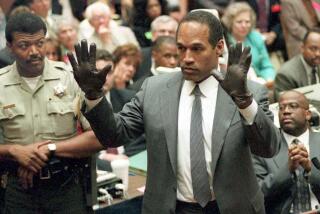A Pager for Our Trivial Pursuits
- Share via
It’s always something.
Things are going well for you, and you’re feeling pretty smug about it. Then, disaster!
There’s a high-speed police chase on a Los Angeles freeway that’s being televised. You know the scene: Half a dozen police cruisers pursuing a van zooming past other motorists, with news choppers overhead and TV anchors wondering aloud whether the driver is Charlie Manson or Osama bin Laden with a load of rocket launchers.
Maybe you’re at work while this chase is occurring. Maybe you’re napping. Maybe you don’t have the set on. Whatever the reason, the catastrophe is . . .
YOU DON’T KNOW ABOUT IT!!!
Not to worry. PursuitWatch to the rescue.
That’s the paging service launched on the Internet last month by Ken Kuwahara, a Los Angeles-area (he wants to keep it vague) police officer who wants you to have access to every cop pursuit shown live on local TV.
About one a week, it seems.
And for an introductory fee of $1 a year for a basic membership, Kuwahara will make sure you know about them. Besides the buck, you need a beeper.
The best thing about this from Kuwahara’s perspective, he noted recently, is that the venture requires hardly any effort from him. Subscribers notify the network that a chase is on TV, either by calling a toll-free hotline or sending an e-mail. Then Kuwahara signals other subscribers on their personal beepers.
Those who pay a higher rate for membership are eligible for the “reward” Kuwahara pays the first subscriber to report a televised chase.
Since opening for business on Jan. 1, PursuitWatch has attracted more than 300 subscribers through its Web site, Kuwahara said. “We’ve given them four notifications already,” he said.
Which affirms that there is a market for everything, even though odds are about zero of there being another chase even close to being as newsworthy or dramatic as O.J. Simpson’s 1994 freeway flight.
Although Kuwahara needs more than several hundred subscribers to make a go of this, he dreams of expanding to other regions if PursuitWatch is successful here. And if it is, why stop with car chases? A televised vote on the Senate floor on whether to convict President Clinton? Nah, borrrrrring. But why not a beeper service calling viewers to the set for televised fires? Or for the next time newscasts lead with a former husband of a celebrity injuring himself falling down a flight of stairs?
Local stations have been saying for some time that their ratings jump when they preempt regular programming to show a chase. “If you’re ever in Circuit City during one of these chases,” Kuwahara said, “you’re gonna see people gathered around the sets.”
Why some watch the TV they do is always a mystery to those with different tastes. The big TV story coming out of Sunday’s Super Bowl, for example, is not that its ratings were the lowest since 1990, but that an estimated 127 million Americans did watch.
Think of it, nearly half the nation witnessing an event in which most have no deep interest or root for one side or the other. Yet they are drawn to this game annually like dogs being summoned by a high-pitched whistle that only they can hear. Most watch because of the media hype, part of which are media who at once complain about the hype and happily take part in it. And more fundamentally they watch because they, too, are being beeped, and relentlessly, having been programmed by professional football and Madison Avenue to believe the Super Bowl to be an event for the ages. Giving it Roman numerals has to go down as one of the genius sales concepts of the millennium.
At least the Super Bowl is punctuated by customized ads that emerge from creative thinking. Even more mysterious, and a subject for students of the human brain, is the attraction of Car Chase XXXIII.
You want to tell these beepees to get a life, or at least change the one they have. In TV’s infant days, Americans would sit like lumps in front of the set transfixed by the test pattern. But TV was then a gimmick.
The chases are now routine.
“What it comes down to is good vs. evil,” Kuwahara believes. “People like seeing cops and robbers.”
His Web site message goes further in defining the appeal: “No one, not even the [TV news] producers, know what the ending will be, perhaps an incredible collision or deadly confrontation.”
Of course, the potential big kablooey. Yet to what end?
You can learn much from a good painting, from peering into the eyes of even a slide of a Van Gogh self-portrait. Especially striking about these televised chases, though, is how they anesthetize the brain while pushing emotional buttons. Although diverting you with movement, they are as flat as an Andy Warhol soup can, offering no texture, shadows, shadings or brush strokes.
There is no care or craft in the making of these live pictures, and you’re rarely smarter for watching them. You learn nothing about the fugitive motorist, nothing about what brought him or her to this moment of crisis, nothing about the mind-sets of the police officers in pursuit, nothing about the conditions of society that may be the incident’s backdrop, and usually no details even about the crime that was its genesis.
In the early 1980s, Norman Corwin wrote of a “low-grade, chronic disease” that was spreading across the U.S. “Now and then the symptoms abate, but they return,” he explained. “For the most part, Americans do not know what they suffer from, and those who do are divided about its nature, whether they want to cure it, and whether it can be cured at all.”
He called the disease the “trivializing” of America. In other words, beep them and they will come.
More to Read
Inside the business of entertainment
The Wide Shot brings you news, analysis and insights on everything from streaming wars to production — and what it all means for the future.
You may occasionally receive promotional content from the Los Angeles Times.










